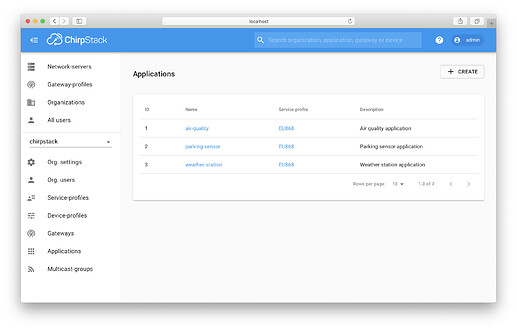About
The ChirpStack open-source LoRaWAN Network Server stack provides open-source components for LoRaWAN networks. Together they form a ready-to-use solution including an user-friendly web-interface for device management and APIs for integration.
The modular architecture makes it possible to integrate within existing infrastructures. All components are licensed under the MIT license and can be used for commercial purposes.
Resources
Features
Class-A support
End-devices of Class A allow for bi-directional communications whereby each end-device‘s uplink transmission is followed by two short downlink receive windows. The transmission slot scheduled by the end-device is based on its own communication needs with a small variation based on a random time basis (ALOHA-type of protocol).
Class-B support
End-devices of Class B allow for more receive slots. In addition to the Class A random receive windows, Class B devices open extra receive windows at scheduled times. In order for the End-device to open it receive window at the scheduled time it receives a time synchronized Beacon from the gateway.
Class-C support
End-devices of Class C have nearly continuously open receive windows, only closed when transmitting. Class C end-device will use more power to operate than Class A or Class B but they offer the lowest latency for server to end-device communication.
Adaptive data-rate
When the end-device has ADR enabled, the ChirpStack LoRaWAN network-server will ensure that the device will operate using the most efficient data-rate and tx-power. this will not only save energy at the device-side, but will also optimize the usage of the radio spectrum, lowering the risk of collisions.
Live frame-logging
The ChirpStack LoRaWAN application-server provides live frame-logging per gateway and device. It will display all the RX / TX meta-data, together with the raw LoRaWAN PHYPayload in a readable format. It is like Wireshark for LoRaWAN!
Channel (re)configuration
Whether you want to use a sub-set of the LoRaWAN defined channels (e.g. for the US band) or want to configure additional channels (e.g. for the EU band), the ChirpStack LoRaWAN network-server will make sure the device stays always in sync with the network configured channels (using the CFList field and / or mac-commands).
Multi-tenant
The ChirpStack LoRaWAN application-server supports the creation of multiple organizations to which (administrator) users can be assigned. By integrating the user-accounts into the MQTT broker authentication, organizations will only see their own data.
APIs and integration
All ChirpStack components provide gRPC and / or REST APIs for integration with external services. By default all application data is published to a MQTT broker, however integrations are available for various cloud-providers, databases and visualization platforms.
LoRaWAN 1.0 and 1.1 compatible
The ChirpStack LoRaWAN network-server supports LoRaWAN 1.0 and LoRaWAN 1.1 devices simultaniously, including all LoRaWAN Regional Parameter Specification revisions and bands.
